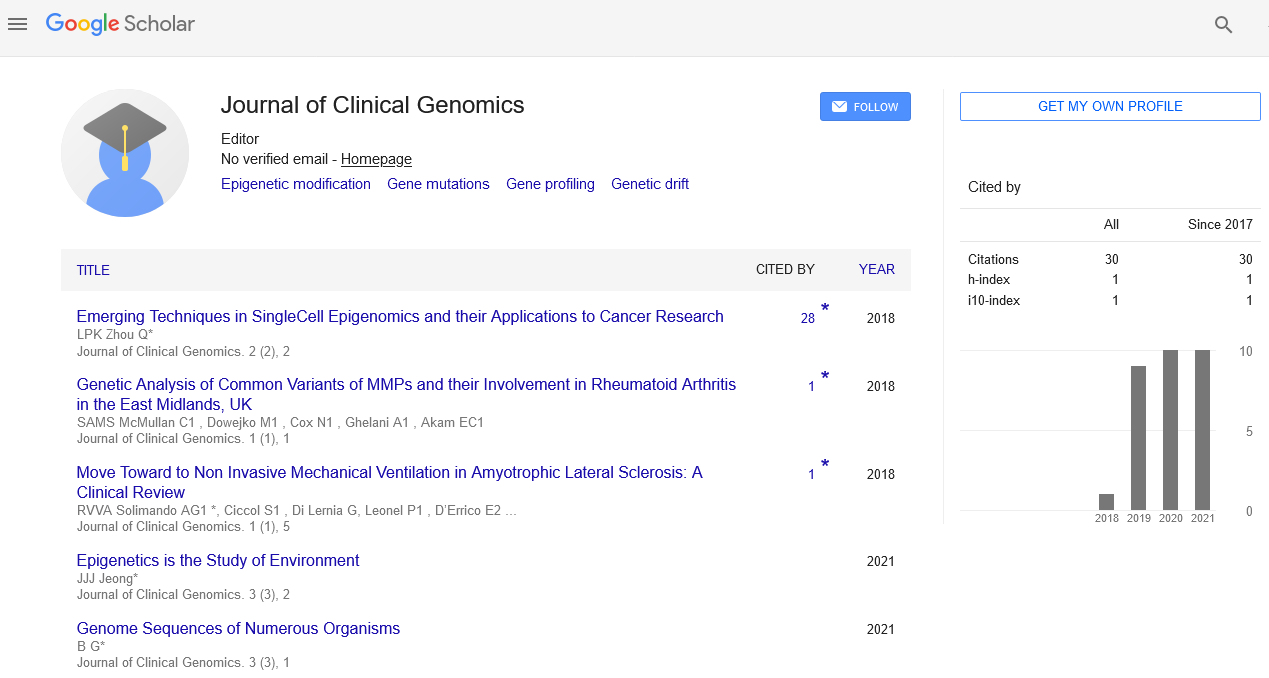Commentary, J Clin Genom Vol: 5 Issue: 4
Enhancing Metagenomic Strategies and Methods for Microbial Ecology
Manjeeb Gupta*
1Department of Biotechnology, Deen Dayal Upadhyaya Gorakhpur University, Gorakhpur, India
*Corresponding Author: Manjeeb Gupta,
Department of Biotechnology, Deen Dayal
Upadhyaya Gorakhpur University, Gorakhpur, India
E-mail: manjeeb_gupta@ddug22.in
Received date: 22 November, 2023, Manuscript No. JCG-24-125701;
Editor assigned date: 24 November, 2023, PreQC No. JCG-24-125701 (PQ);
Reviewed date: 11 December, 2023, QC No. JCG-24-125701;
Revised date: 19 December, 2023, Manuscript No. JCG-24-125701 (R);
Published date: 26 December, 2023, DOI: 110.4172/JCG.1000147
Citation: Gupta M (2023) Enhancing Metagenomic Strategies and Methods for Microbial Ecology. J Clin Genom 5:4.
Description
In the intricate tapestry of life on Earth, microbial communities play a pivotal role in shaping ecosystems, influencing nutrient cycles, and maintaining ecological balance. Metagenomics, the study of genetic material recovered directly from environmental samples, has revolutionized the ability to explore and understand microbial diversity. It delves into the exciting realm of metagenomics, highlighting strategies and methods that contribute to a deeper comprehension of microbial ecology and its profound implications.
Shotgun metagenomics involves sequencing all the genetic material within a sample, providing a comprehensive overview of microbial diversity. This strategy allows analysts to explore the functional potential of microbial communities, identifying genes involved in processes such as nutrient cycling, antibiotic resistance, and biofilm formation. Targeting the 16S ribosomal RNA (rRNA) gene is a widely used strategy for assessing microbial diversity. This gene is highly conserved across bacteria and archaea, making it a valuable marker for taxonomic identification. 16S rRNA gene sequencing provides insights into the composition of microbial communities, aiding in the classification of bacteria and archaea present in a given environment.
Functional metagenomics focuses on identifying genes that contribute to specific functions within microbial communities. By cloning and expressing environmental DNA in heterologous hosts, analysts can explore the functional capabilities of microbial communities, uncovering novel enzymes, biosynthetic pathways, and metabolic processes. Metatranscriptomics delves into the RNA molecules expressed by microbial communities, providing a dynamic view of gene activity. This strategy helps elucidate which genes are actively involved in processes such as nutrient cycling, stress response, and communication among microorganisms, providing valuable insights into the functional dynamics of microbial ecosystems.
Metaproteomics involves the identification and quantification of proteins within microbial communities. By studying the protein composition, experts can infer the functional activities of microbial populations. This strategy provides a direct link between the genetic potential of a community and the proteins expressed under specific environmental conditions. Single-cell genomics enables the study of individual microbial cells, providing insights into the genetic diversity within populations. This method is particularly valuable for unculturable microorganisms and allows analysts to explore genomic variation at the single-cell level, contributing to a more nuanced understanding of microbial community dynamics.
Advances in long-read sequencing technologies, such as PacBio and Oxford Nanopore sequencing, have overcome limitations associated with short-read sequencing. These technologies enable the sequencing of longer DNA fragments, facilitating the assembly of more complete and accurate microbial genomes from complex environmental samples. Computational approaches, including in silico metagenomics, leverage bioinformatics tools to analyze and interpret metagenomic data. Machine learning algorithms and advanced statistical methods help predict microbial functions, assess community dynamics, and identify key players in ecological processes, enhancing the ability to extract meaningful insights from complex datasets.
Enhancing metagenomic strategies and methods holds significant implications for the understanding of microbial ecology. The ability to unravel the intricate relationships between microorganisms in diverse environments contributes to advancements in fields such as environmental science, agriculture, and biotechnology. The ongoing refinement of metagenomic approaches opens new frontiers for exploration. As technologies evolve and computational tools become more sophisticated, studies can delve deeper into microbial communities, uncovering hidden interactions, and gaining a more holistic perspective on the functioning of ecosystems.
Conclusion
Metagenomics has transformed the ability to explore the hidden realms of microbial ecology, providing a lens into the diversity, functions, and interactions of microorganisms that shape the world around us. By enhancing metagenomic strategies and methods, experts are not only expanding the understanding of microbial ecosystems but also paving the way for practical applications in fields ranging from environmental conservation to medical science. As technology continues to advance, the synergy between experimental and computational approaches will propel metagenomics into exciting new frontiers. The enhanced ability to decipher the genomic blueprints of microbial communities promises to unlock the secrets of microbial ecology, providing valuable knowledge that can be harnessed for the betterment of the planet and the myriad of life it sustains.
 Spanish
Spanish  Chinese
Chinese  Russian
Russian  German
German  French
French  Japanese
Japanese  Portuguese
Portuguese  Hindi
Hindi 